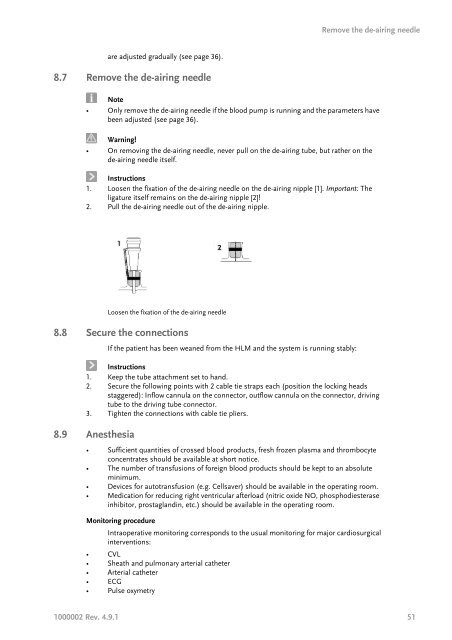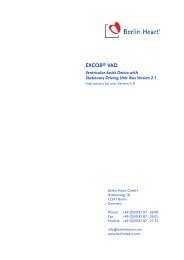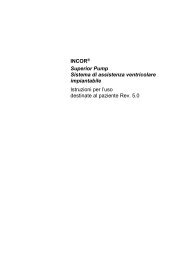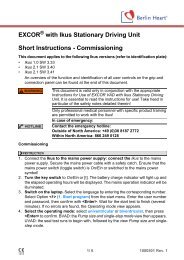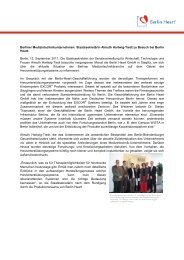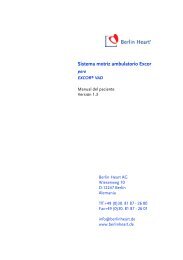Instructions for use: Ikus - Berlin Heart
Instructions for use: Ikus - Berlin Heart
Instructions for use: Ikus - Berlin Heart
You also want an ePaper? Increase the reach of your titles
YUMPU automatically turns print PDFs into web optimized ePapers that Google loves.
are adjusted gradually (see page 36).<br />
8.7 Remove the de-airing needle<br />
Remove the de-airing needle<br />
Note<br />
• Only remove the de-airing needle if the blood pump is running and the parameters have<br />
been adjusted (see page 36).<br />
Warning!<br />
• On removing the de-airing needle, never pull on the de-airing tube, but rather on the<br />
de-airing needle itself.<br />
<strong>Instructions</strong><br />
1. Loosen the fixation of the de-airing needle on the de-airing nipple [1]. Important: The<br />
ligature itself remains on the de-airing nipple [2]!<br />
2. Pull the de-airing needle out of the de-airing nipple.<br />
Loosen the fixation of the de-airing needle<br />
8.8 Secure the connections<br />
If the patient has been weaned from the HLM and the system is running stably:<br />
<strong>Instructions</strong><br />
1. Keep the tube attachment set to hand.<br />
2. Secure the following points with 2 cable tie straps each (position the locking heads<br />
staggered): Inflow cannula on the connector, outflow cannula on the connector, driving<br />
tube to the driving tube connector.<br />
3. Tighten the connections with cable tie pliers.<br />
8.9 Anesthesia<br />
• Sufficient quantities of crossed blood products, fresh frozen plasma and thrombocyte<br />
concentrates should be available at short notice.<br />
• The number of transfusions of <strong>for</strong>eign blood products should be kept to an absolute<br />
minimum.<br />
• Devices <strong>for</strong> autotransfusion (e.g. Cellsaver) should be available in the operating room.<br />
• Medication <strong>for</strong> reducing right ventricular afterload (nitric oxide NO, phosphodiesterase<br />
inhibitor, prostaglandin, etc.) should be available in the operating room.<br />
Monitoring procedure<br />
Intraoperative monitoring corresponds to the usual monitoring <strong>for</strong> major cardiosurgical<br />
interventions:<br />
• CVL<br />
• Sheath and pulmonary arterial catheter<br />
• Arterial catheter<br />
• ECG<br />
• Pulse oxymetry<br />
1000002 Rev. 4.9.1 51


